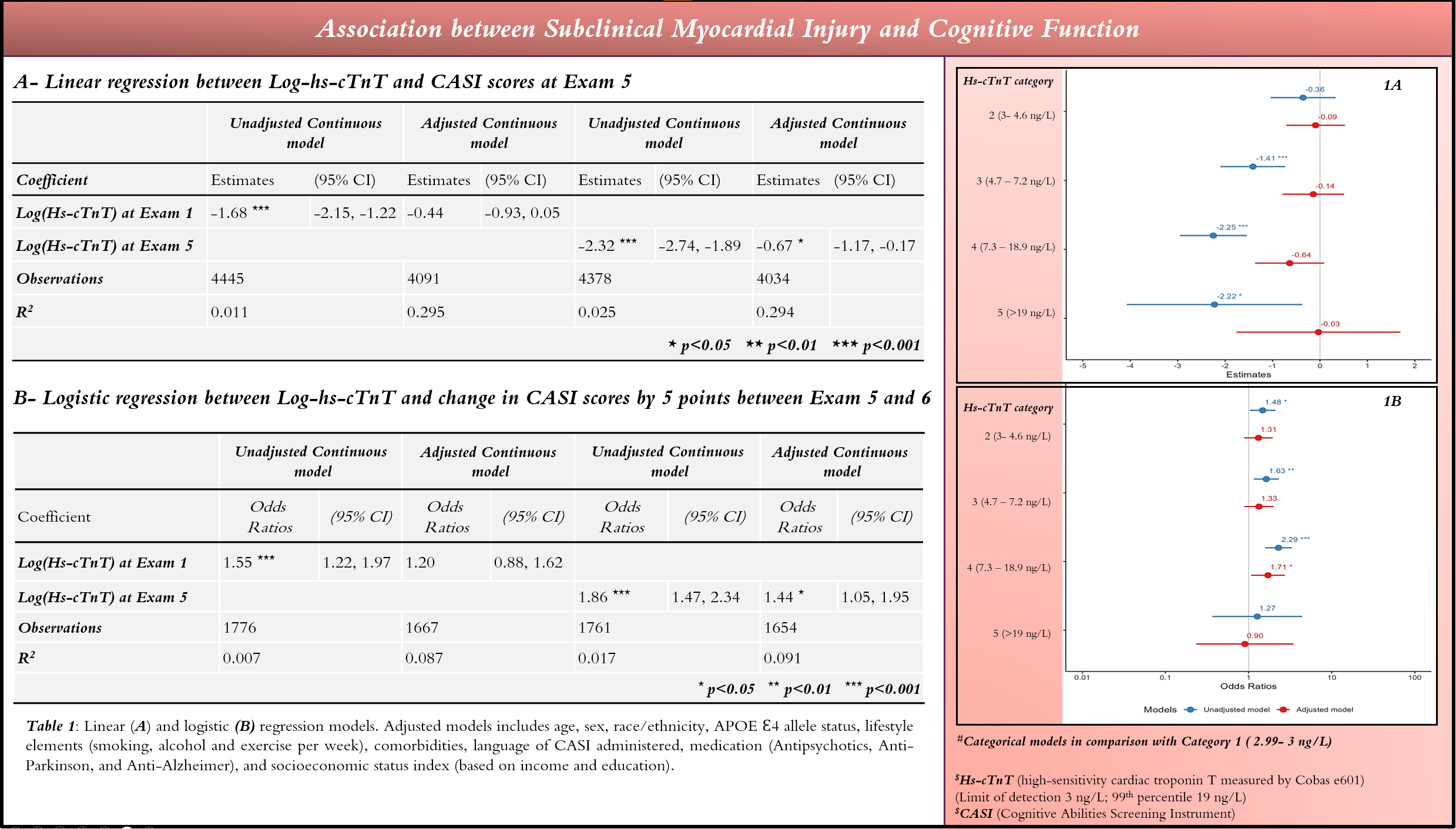Final ID: 4137155
Relationship between Subclinical Myocardial Injury and Global Cognitive Performance: The Multi-Ethnic Study of Atherosclerosis (MESA)
Abstract Body (Do not enter title and authors here): Background: With demographic trends transitioning towards older adults, dementia and cognitive impairment are predicted to increase dramatically. We aim to elucidate the relationship between subclinical myocardial injury, as indicated by asymptomatic increased levels of high-sensitivity cardiac Troponin (hs-cTnT), and cognitive performance.
Methods: We studied MESA participants from Exam 1 (2000-02) to Exam 6 (2016-18), categorizing them based on baseline hs-cTnT at Exam 1. Cognitive decline was defined as a decrease of ≥5 units in CASI between Exam 5 & 6. We used Pearson correlation and linear regression to analyze the association of hs-cTnT levels with CASI scores, and logistic regression to examine the association with cognitive decline. We also explored the relationship between different hs-cTnT categories and cognitive measures. Models were adjusted for demographics, lifestyle, APOE status, comorbidities, and medication use (Figure).
Results: 4445 participants had both baseline hs-cTnT and valid Exam 5 CASI scores while only 1776 participants had valid Exam 6 CASI scores. Cohort was predominantly female (53%), mean age of 60 years, and 27% had at least one APOE e4 allele. Median hs-cTnT was 6.32 ng/L, and median CASI scores were 89 at Exam 5 and 91.5 at Exam 6. We found a negative correlation between the log-hs-cTnT at Exam 1 and Exam 5 with CASI scores at Exam 5. An increase of one unit in log-hs-cTnT level was associated with a decrease of 0.67 (CI -1.17, -0.17) in CASI and corresponded to higher odds (OR: 1.44; CI 1.05-1.95) of cognitive decline, after adjusting for covariates. When comparing various categories of hs-cTnT with category 1, we observe that the odd of cognitive decline increases as the category increases. However, this trend does not hold for category 5 with significantly lower sample size (Figure).
Conclusion: Our findings indicate an inverse relationship between hs-cTnT and cognitive function years later, which is significantly attenuated by known risk factors for cognitive decline. Further research is needed to determine hs-cTnT as a predictor of future global cognitive functions.
Methods: We studied MESA participants from Exam 1 (2000-02) to Exam 6 (2016-18), categorizing them based on baseline hs-cTnT at Exam 1. Cognitive decline was defined as a decrease of ≥5 units in CASI between Exam 5 & 6. We used Pearson correlation and linear regression to analyze the association of hs-cTnT levels with CASI scores, and logistic regression to examine the association with cognitive decline. We also explored the relationship between different hs-cTnT categories and cognitive measures. Models were adjusted for demographics, lifestyle, APOE status, comorbidities, and medication use (Figure).
Results: 4445 participants had both baseline hs-cTnT and valid Exam 5 CASI scores while only 1776 participants had valid Exam 6 CASI scores. Cohort was predominantly female (53%), mean age of 60 years, and 27% had at least one APOE e4 allele. Median hs-cTnT was 6.32 ng/L, and median CASI scores were 89 at Exam 5 and 91.5 at Exam 6. We found a negative correlation between the log-hs-cTnT at Exam 1 and Exam 5 with CASI scores at Exam 5. An increase of one unit in log-hs-cTnT level was associated with a decrease of 0.67 (CI -1.17, -0.17) in CASI and corresponded to higher odds (OR: 1.44; CI 1.05-1.95) of cognitive decline, after adjusting for covariates. When comparing various categories of hs-cTnT with category 1, we observe that the odd of cognitive decline increases as the category increases. However, this trend does not hold for category 5 with significantly lower sample size (Figure).
Conclusion: Our findings indicate an inverse relationship between hs-cTnT and cognitive function years later, which is significantly attenuated by known risk factors for cognitive decline. Further research is needed to determine hs-cTnT as a predictor of future global cognitive functions.
More abstracts on this topic:
APOe Genotype Modifies the Association Between Long-Term Blood Pressure Variability and Cognitive Decline/Dementia in Older Adults
Ernst Michael, Wolfe Rory, Murray Anne, Shah Raj, Polkinghorne Kevan, Reid Christopher, Lacaze Paul, Ryan Joanne, Webb Katherine, Sheets Kerry, Woods Robyn, Fravel Michelle, Beilin Lawrence, Espinoza Sara, Orchard Suzanne, Owen Alice
Artificial Intelligence-Based Coronary Artery Calcium (AI-CAC) Score Empowers the “Power of Zero”: An AI-CVD Study within the Multi-Ethnic Study of Atherosclerosis (MESA)Naghavi Morteza, Vliegenthart Rozemarijn, Nasir Khurram, Narula Jagat, Benjamin Emelia, Levy Daniel, Henschke Claudia, Yankelevitz David, Wong Nathan, Atlas Kyle, Zhang Chenyu, Reeves Anthony, Atlas Thomas, Wasserthal Jakob, Mcconnell Mike, Maron David, Williams Kim

